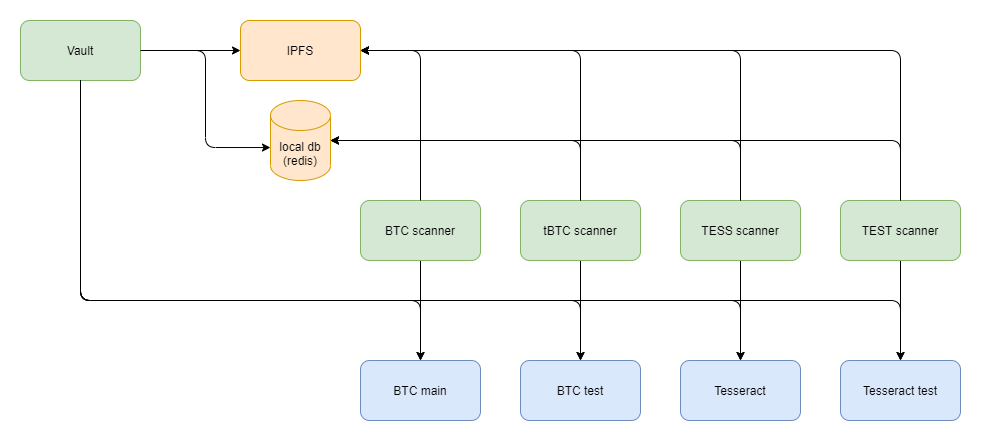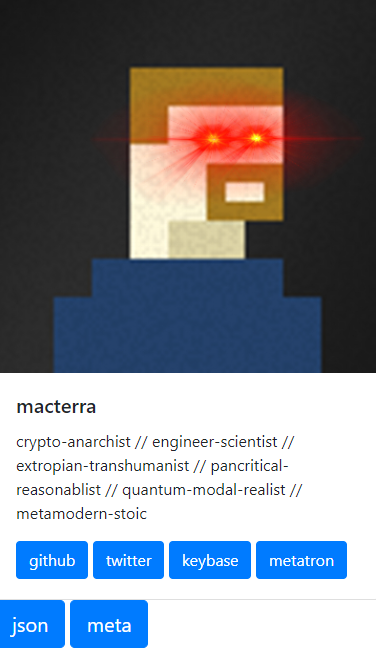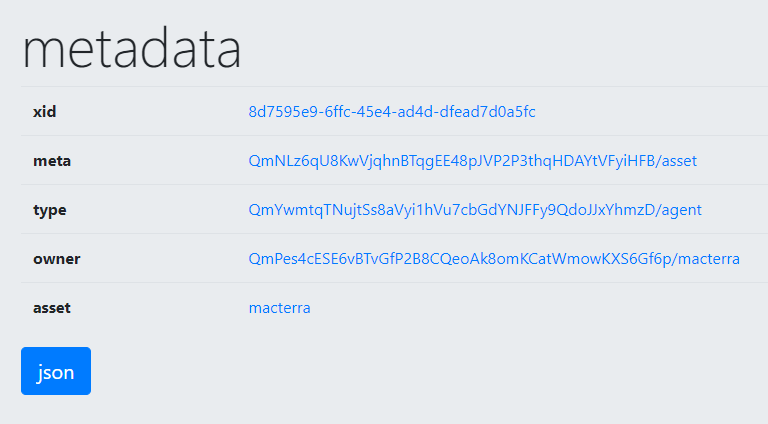metatron
Metatron
The Metatron system is designed to establish an authorized version chain in a decentralized manner for any digital asset stored on IPFS. Since IPFS is designed to permanently publish information that is unchanging and unchangeable, anybody can publish a revision. Given an IPFS link, how can users discover the most recent authorized version, i.e. the revision that is designated as authoritative by the current owner of the information, for example someone’s resume?
Metatron takes advantage of blockchain features to establish a single chain of authorized versions from a potential tree of unauthorized versions. It does so by associating the current version with an unspent transaction output (UTXO) on the blockchain. Whoever has the private key to spend the UTXO has the right to authorize the next version. Since the blockchain ensures that a given UTXO can only be spent once, a single history of authorized versions can be established without any central authorities.
The Extensible Identifier (xid)
The system provides a way to establish ownership of 128-bit random numbers called xid (for eXtensible IDentifier)
The value of the xid must be a random UUID
- any UUID that can be compressed by zlib to less than its original length of 16 bytes will be considered invalid
- the xid should be a pure indexical, it should be able to point to any digital content without bias, including nothing in the case it is retired or disabled
- therefore the xid should contain no internal information (though, to be fair, it is always possible to encode encrypted information via the UUID5 standard)
The xid is associated with digital content by mapping it to a content identifier (CID) on IPFS
- if the CID resolves to a directory, it must have a top-level file named
meta.jsonthat includes a top-level property namedxid - if the CID resolves to a IPLD node, it should have a top-level object named
metathat includes a top-level property namedxid(TBD) - if the CID resolves to a file, it is ignored
Rules of ownership
Precedence
- blockchain agnostic, precedence by block time
- testnet claims are provisional and may be overridden by any mainnet
- every metatron node may decide which blockchains to scan
- this means that a node that scans only bitcoin may not recognize the ownership claims submitted to RavenCoin for example
- let the market decide which blockchains should be used for this purpose
Bitcoin-derived blockchains
- ownership claims are submitted in special txns called auth txns (short for authorization transactions)
- the auth txn must contain one unspendable nulldata txo encoding IPFS CID (v0 or v1 multihash) at
voutindex 0 - the auth txn must contain one spendable txo at
voutindex 1 that establishes the chain of ownership of the xid- sufficiently low valued transactions are prohibited by the bitcoin consensus as “dust” because it costs more in transaction fees to spend them than they are worth
- the value staked in the auth txn must be greater than the current dust value
- in order to update the metadoc for a given xid, a subsequent auth txn MUST spend the previous auth txo (this is the essential key to the whole system)
- anyone can copy and publish a new version of the metadoc since it is public information
- only the owner can publish an
authorized version
- the txn will necessarily contain additional inputs and outputs to cover blockchain fees
- it is the responsibility of the authorization software to ensure that auth txos are used only to update ownership claims, not for fees
Operation
The system scans new blocks for auth transactions, validates them, generates version certificates for valid ones, and updates the version database. The version database simply maps each extent xid to the cid of the latest version certificate. Instances of the system that implement that same consensus rules and scan the same set of blockchains will necessarily converge on the same version database state analogously to the unspent transaction output (UTXO) set for a particular blockchain.
Nodes can sync with each other by authorizing their version database on the blockchain where other nodes can pick them up in their regular scans and compare them to their local versions to detect and correct any inconsistencies. This mechanism also provides a way for new nodes to synchronize quickly without scanning each entire blockchain from the beginning or a specific date. Validating the most recent version requires validating each previous version.

- The first version of a document (or image) is created and added to IPFS.
- A metadata document references the CID of the doc v1. A random
idxis generated for this object. It is the only property that must remain constant for the life of the object. - The first version is authorized by submitting an auth txn to a blockchain. The txn references the CID of the metadoc.
- A blockchain scanner discovers the auth txn when it is confirmed on a block. The metadoc will be resolved from its CID on IPFS. The scanner will search its db for the idx in the metadoc but it won’t be found since it is new. The scanner can confirm that the transaction inputs referenced in the auth txn are not auth txns. The first version of the block certification block-cert is created and added to IPFS. The idx is mapped to the CID of the block-cert in the db.
- The author creates a new revision of the image, doc v2.
- The system updates the metadoc referencing the CID of the v2 of the doc and the CID of v1 of the metadoc.
- The second version is authorized by submitting an auth txn to the blockchain that references the CID of v2 of the metadoc and spends the UTXO from the first auth txn.
- The blockchain scanner discovers the v2 auth txn when it is confirmed on a block. Again it finds the idx by resolving the metadoc from IPFS. This time it finds the idx in the db mapped to the first block-cert. The scanner can confirm that the new auth txn spends the auth txn referenced in the block-cert. If everything checks out a new block-cert is created and added to IPFS. The db is updated so that idx is now mapped to the new block-cert.
- The process is repeated for a 3rd version of the image
- A new metadoc is created and added to IPFS.
- An auth txn is submitted that references the new metadoc and spends the txo from the last auth txn.
- The scanner discovers the new auth txn on the blockchain, verifies all the references are valid, creates a new block-cert, adds it to IPFS, and updates the db so that the idx is mapped to the latest version.
Metatron Node
A Metatron node is a server running a number of interoperating services in docker containers.

Vault
The vault is the main UI for the system. The vault can be configured to connect to any number of blockchain nodes, using their built-in wallets to store and authorize assets.
The vault also acts as an asset explorer, listing all assets discovered and validated by the scanners. Using the explorer feature, the user can view the complete authorized version history of any asset. The explorer set of features could be split into its own application separate from the vault, separating concerns that require user authentication (vault) from those that may be accessed anonymously (explorer).
Blockchain nodes
Each blockchain node is a docker containerized version of a full node that validates transactions and blocks for a particular blockchain. The diagram illustrates four blockchains, the mainnet and testnet chains for Bitcoin and Tesseract, though the Metatron system can support any number of blockchains.
Scanners
A scanner is a background process that is configured to connect to a single blockchain node and scan each new block for Metatron transactions. When a transaction is detected and validated, the scanner generates an authorized version certificate, publishes it to IPFS, and updates the latest version entry in the local database (redis). Scanners also keep track of which blocks they have scanned in the local db so that when the system restarts it can pick up where it left off.
Futures
Eventually we will want a reverse proxy front end such as nginx to hide the various service ports behind a single set of URLs on port 80.
It will be useful to add metrics, logs, alerts, and general observability to the system, perhaps through TICK and ELK stacks running in containers.
Other blockchains under consideration to expand the system:
- Ravencoin
- Ethereum
- Cardano
Asset Type System
The Metatron protocol described above is designed to establish ownership of an xid.
The owner of the xid can associate it with any (digital) information desired, so long as it conforms to the protocol.
The Asset Type System is a set of conventions built on top of the protocol that enables the association between the xid and some other information in a self-descriptive way.
For example the source code of the Metatron system itself (including this documentation) is authorized on the Metatron network as an instance of the git-repo type.
Another example is the macterra agent asset which is accessible at https://ipfs.io/ipfs/QmY5SeuArETTj1hy1UMz14KtPL3eM1hHJkRzimuSVzP8vR/macterra/

The json button at the bottom reveals the underlying data used to automatically generate the HTML for the agent page:
{
"name": "macterra",
"headline": "crypto-anarchist // engineer-scientist // extropian-transhumanist // pancritical-reasonablist // quantum-modal-realist // metamodern-stoic",
"image": "media/laser-eyes.jpg",
"links": {
"github": "https://github.com/macterra",
"twitter": "https://twitter.com/macterra",
"keybase": "https://keybase.io/mcfadzean",
"metatron": "https://macterra.github.io/metatron/"
}
}
The meta button at the bottom will navigate up one level to https://ipfs.io/ipfs/QmY5SeuArETTj1hy1UMz14KtPL3eM1hHJkRzimuSVzP8vR/

The json button at the bottom reveals the underlying data used to automatically generate the HTML for the metadata page:
{
"xid": "deec9958-c0a0-4090-bf98-9fa4ed9c2da7",
"home": "http://btc.metagamer.org:5000/versions/xid/",
"meta": "QmNLz6qU8KwVjqhnBTqgEE48pJVP2P3thqHDAYtVFyiHFB/asset",
"type": "QmYwmtqTNujtSs8aVyi1hVu7cbGdYNJFFy9QdoJJxYhmzD/agent",
"owner": "QmWZcJBMbL64RyLVwLmtRs4JkjHiAYJEeqxS7Rwzh2ran2/macterra",
"asset": "macterra"
}
The xid deec9958-c0a0-4090-bf98-9fa4ed9c2da7 is what is owned on the blockchain, and the only necessary constant across versions.
The home http://btc.metagamer.org:5000/versions/xid/ is the address of the Metatron system that authorized this version. It is used to access previous and possibly future versions of this asset, notably the most recent version.
The meta QmNLz6qU8KwVjqhnBTqgEE48pJVP2P3thqHDAYtVFyiHFB/asset references the asset type that defines how to interpret the metadata.
The type QmYwmtqTNujtSs8aVyi1hVu7cbGdYNJFFy9QdoJJxYhmzD/agent references the agent type that defines how to interpret the subfolder data, specified in the asset property macterra that also serves as the name of this asset.
The owner QmWZcJBMbL64RyLVwLmtRs4JkjHiAYJEeqxS7Rwzh2ran2/macterra references an agent that owns this asset. Agent assets are distinguished by being self-owned, but necessarily by an earlier version of the agent.
All types are assets, but not all assets are types. The macterra asset is an instance of the agent type, but is not a type itself. The agent asset is also a type.
In general, all assets have an xid, a type, and an owner. The type is an asset derived from the special type named type, and the owner is an agent asset.
